Unit 187 Operations Management: A Case Study of Mango's Practices
VerifiedAdded on 2023/06/07
|14
|4721
|334
Report
AI Summary
This report provides a detailed review and critique of Mango's operations management practices. It begins with an introduction to Mango, differentiating between operation and operations management, followed by an analysis of how Mango implements operations management principles. The report assesses the extent to which Mango's operations management meets organizational requirements, discussing continuous improvement as a philosophy and describing lean principles. It includes a continuous improvement plan with justified recommendations based on the review of operations management principles within Mango. The analysis covers aspects such as lean production, agile manufacturing, and the application of Six Sigma principles to enhance Mango's operational efficiency and effectiveness in the fashion industry.

ID
Unit Number and Title Unit 187 –
Operations and
Project Management
Title Review and Critique
of Operations
Management (Part
1
Unit Number and Title Unit 187 –
Operations and
Project Management
Title Review and Critique
of Operations
Management (Part
1
Paraphrase This Document
Need a fresh take? Get an instant paraphrase of this document with our AI Paraphraser

Table of Content
Part 1: Business Report
1. An introduction to chosen organization p
2. An explanation of operation vs operations management p
3. A review and critique of the implementation of operations
management principles within the chosen organization p
4. An analysis of the extent to which the operations management of
the organisation in the case study meets the requirements of the
organization p
5. Discussion of continuous improvement as a philosophy and
describe the Lean principles p
6. A continuous improvement plan, including your justified
recommendations for improvement, based on your review and
critique of operations management principles within your
organization p
7. Conclusion p
References p
2
Part 1: Business Report
1. An introduction to chosen organization p
2. An explanation of operation vs operations management p
3. A review and critique of the implementation of operations
management principles within the chosen organization p
4. An analysis of the extent to which the operations management of
the organisation in the case study meets the requirements of the
organization p
5. Discussion of continuous improvement as a philosophy and
describe the Lean principles p
6. A continuous improvement plan, including your justified
recommendations for improvement, based on your review and
critique of operations management principles within your
organization p
7. Conclusion p
References p
2
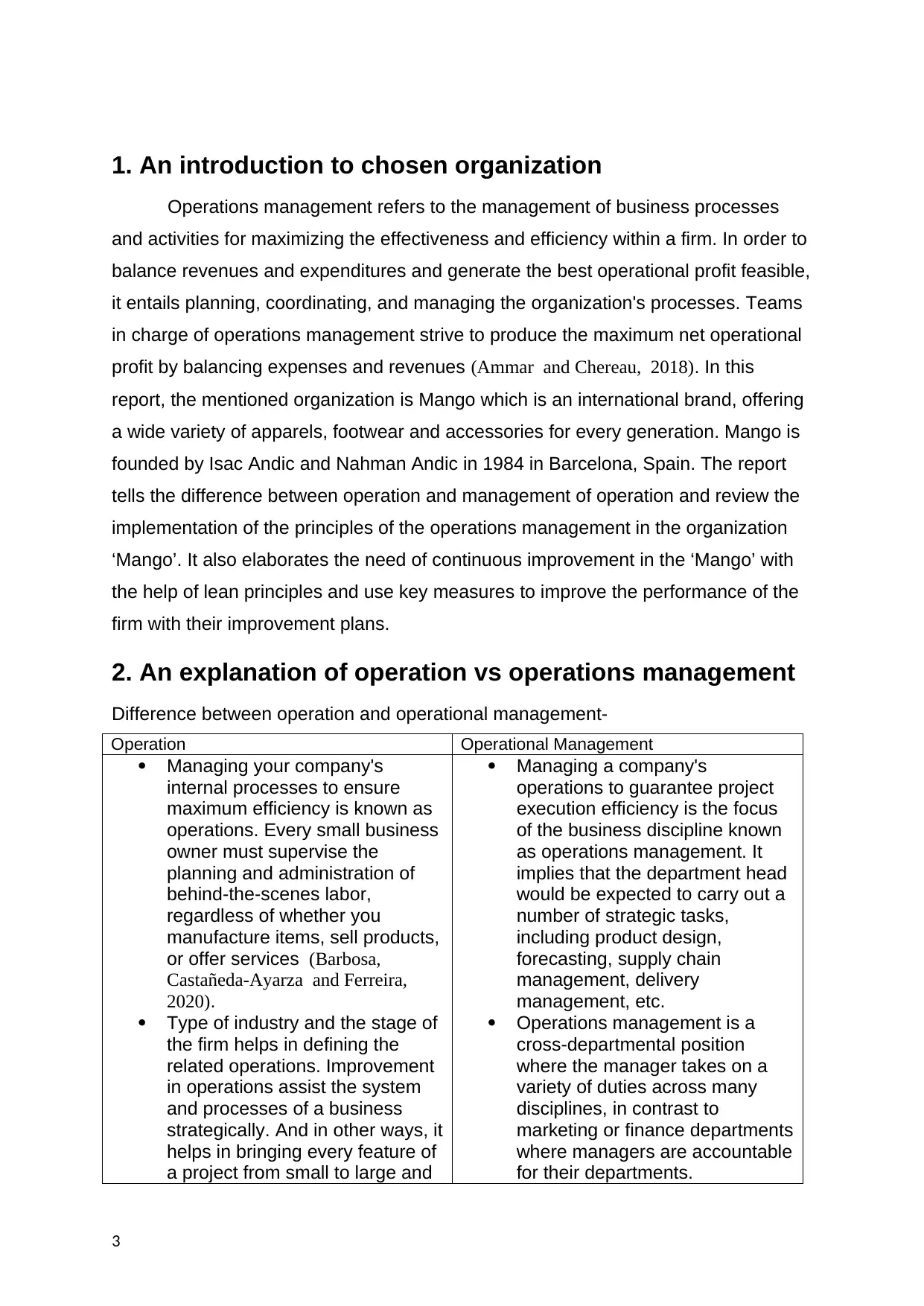
1. An introduction to chosen organization
Operations management refers to the management of business processes
and activities for maximizing the effectiveness and efficiency within a firm. In order to
balance revenues and expenditures and generate the best operational profit feasible,
it entails planning, coordinating, and managing the organization's processes. Teams
in charge of operations management strive to produce the maximum net operational
profit by balancing expenses and revenues (Ammar and Chereau, 2018). In this
report, the mentioned organization is Mango which is an international brand, offering
a wide variety of apparels, footwear and accessories for every generation. Mango is
founded by Isac Andic and Nahman Andic in 1984 in Barcelona, Spain. The report
tells the difference between operation and management of operation and review the
implementation of the principles of the operations management in the organization
‘Mango’. It also elaborates the need of continuous improvement in the ‘Mango’ with
the help of lean principles and use key measures to improve the performance of the
firm with their improvement plans.
2. An explanation of operation vs operations management
Difference between operation and operational management-
Operation Operational Management
Managing your company's
internal processes to ensure
maximum efficiency is known as
operations. Every small business
owner must supervise the
planning and administration of
behind-the-scenes labor,
regardless of whether you
manufacture items, sell products,
or offer services (Barbosa,
Castañeda-Ayarza and Ferreira,
2020).
Type of industry and the stage of
the firm helps in defining the
related operations. Improvement
in operations assist the system
and processes of a business
strategically. And in other ways, it
helps in bringing every feature of
a project from small to large and
Managing a company's
operations to guarantee project
execution efficiency is the focus
of the business discipline known
as operations management. It
implies that the department head
would be expected to carry out a
number of strategic tasks,
including product design,
forecasting, supply chain
management, delivery
management, etc.
Operations management is a
cross-departmental position
where the manager takes on a
variety of duties across many
disciplines, in contrast to
marketing or finance departments
where managers are accountable
for their departments.
3
Operations management refers to the management of business processes
and activities for maximizing the effectiveness and efficiency within a firm. In order to
balance revenues and expenditures and generate the best operational profit feasible,
it entails planning, coordinating, and managing the organization's processes. Teams
in charge of operations management strive to produce the maximum net operational
profit by balancing expenses and revenues (Ammar and Chereau, 2018). In this
report, the mentioned organization is Mango which is an international brand, offering
a wide variety of apparels, footwear and accessories for every generation. Mango is
founded by Isac Andic and Nahman Andic in 1984 in Barcelona, Spain. The report
tells the difference between operation and management of operation and review the
implementation of the principles of the operations management in the organization
‘Mango’. It also elaborates the need of continuous improvement in the ‘Mango’ with
the help of lean principles and use key measures to improve the performance of the
firm with their improvement plans.
2. An explanation of operation vs operations management
Difference between operation and operational management-
Operation Operational Management
Managing your company's
internal processes to ensure
maximum efficiency is known as
operations. Every small business
owner must supervise the
planning and administration of
behind-the-scenes labor,
regardless of whether you
manufacture items, sell products,
or offer services (Barbosa,
Castañeda-Ayarza and Ferreira,
2020).
Type of industry and the stage of
the firm helps in defining the
related operations. Improvement
in operations assist the system
and processes of a business
strategically. And in other ways, it
helps in bringing every feature of
a project from small to large and
Managing a company's
operations to guarantee project
execution efficiency is the focus
of the business discipline known
as operations management. It
implies that the department head
would be expected to carry out a
number of strategic tasks,
including product design,
forecasting, supply chain
management, delivery
management, etc.
Operations management is a
cross-departmental position
where the manager takes on a
variety of duties across many
disciplines, in contrast to
marketing or finance departments
where managers are accountable
for their departments.
3
⊘ This is a preview!⊘
Do you want full access?
Subscribe today to unlock all pages.

Trusted by 1+ million students worldwide
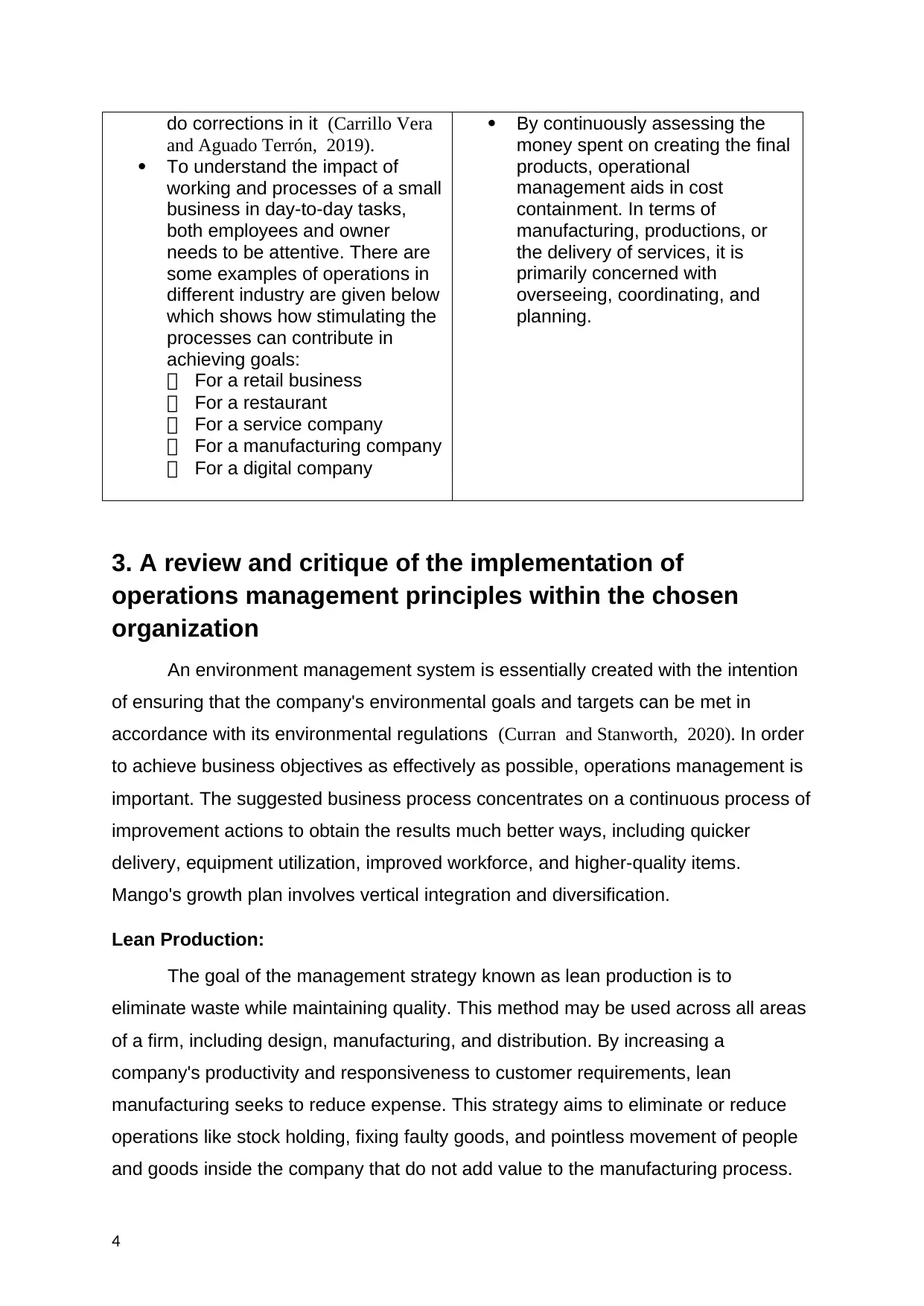
do corrections in it (Carrillo Vera
and Aguado Terrón, 2019).
To understand the impact of
working and processes of a small
business in day-to-day tasks,
both employees and owner
needs to be attentive. There are
some examples of operations in
different industry are given below
which shows how stimulating the
processes can contribute in
achieving goals:
For a retail business
For a restaurant
For a service company
For a manufacturing company
For a digital company
By continuously assessing the
money spent on creating the final
products, operational
management aids in cost
containment. In terms of
manufacturing, productions, or
the delivery of services, it is
primarily concerned with
overseeing, coordinating, and
planning.
3. A review and critique of the implementation of
operations management principles within the chosen
organization
An environment management system is essentially created with the intention
of ensuring that the company's environmental goals and targets can be met in
accordance with its environmental regulations (Curran and Stanworth, 2020). In order
to achieve business objectives as effectively as possible, operations management is
important. The suggested business process concentrates on a continuous process of
improvement actions to obtain the results much better ways, including quicker
delivery, equipment utilization, improved workforce, and higher-quality items.
Mango's growth plan involves vertical integration and diversification.
Lean Production:
The goal of the management strategy known as lean production is to
eliminate waste while maintaining quality. This method may be used across all areas
of a firm, including design, manufacturing, and distribution. By increasing a
company's productivity and responsiveness to customer requirements, lean
manufacturing seeks to reduce expense. This strategy aims to eliminate or reduce
operations like stock holding, fixing faulty goods, and pointless movement of people
and goods inside the company that do not add value to the manufacturing process.
4
and Aguado Terrón, 2019).
To understand the impact of
working and processes of a small
business in day-to-day tasks,
both employees and owner
needs to be attentive. There are
some examples of operations in
different industry are given below
which shows how stimulating the
processes can contribute in
achieving goals:
For a retail business
For a restaurant
For a service company
For a manufacturing company
For a digital company
By continuously assessing the
money spent on creating the final
products, operational
management aids in cost
containment. In terms of
manufacturing, productions, or
the delivery of services, it is
primarily concerned with
overseeing, coordinating, and
planning.
3. A review and critique of the implementation of
operations management principles within the chosen
organization
An environment management system is essentially created with the intention
of ensuring that the company's environmental goals and targets can be met in
accordance with its environmental regulations (Curran and Stanworth, 2020). In order
to achieve business objectives as effectively as possible, operations management is
important. The suggested business process concentrates on a continuous process of
improvement actions to obtain the results much better ways, including quicker
delivery, equipment utilization, improved workforce, and higher-quality items.
Mango's growth plan involves vertical integration and diversification.
Lean Production:
The goal of the management strategy known as lean production is to
eliminate waste while maintaining quality. This method may be used across all areas
of a firm, including design, manufacturing, and distribution. By increasing a
company's productivity and responsiveness to customer requirements, lean
manufacturing seeks to reduce expense. This strategy aims to eliminate or reduce
operations like stock holding, fixing faulty goods, and pointless movement of people
and goods inside the company that do not add value to the manufacturing process.
4
Paraphrase This Document
Need a fresh take? Get an instant paraphrase of this document with our AI Paraphraser
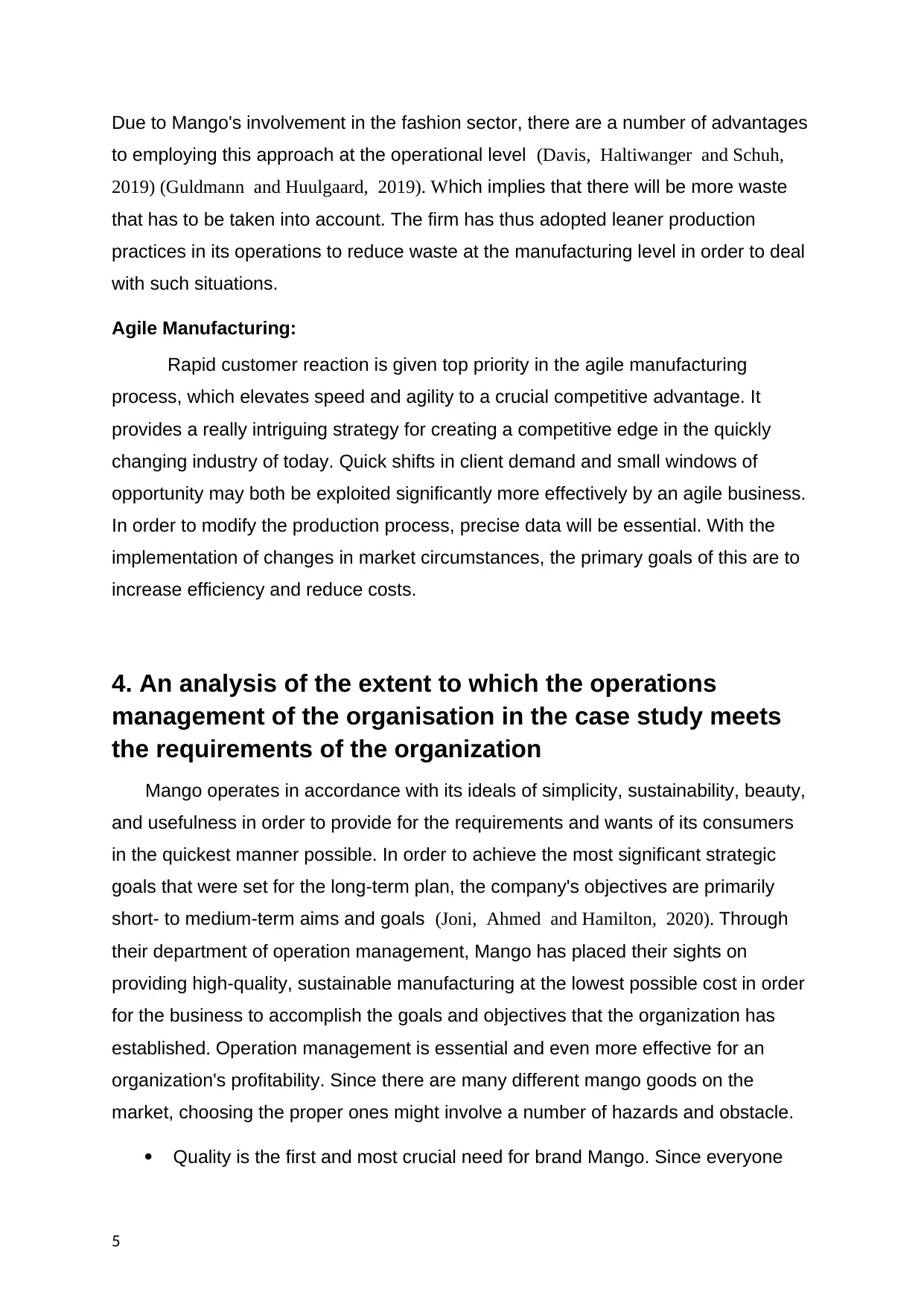
Due to Mango's involvement in the fashion sector, there are a number of advantages
to employing this approach at the operational level (Davis, Haltiwanger and Schuh,
2019) (Guldmann and Huulgaard, 2019). Which implies that there will be more waste
that has to be taken into account. The firm has thus adopted leaner production
practices in its operations to reduce waste at the manufacturing level in order to deal
with such situations.
Agile Manufacturing:
Rapid customer reaction is given top priority in the agile manufacturing
process, which elevates speed and agility to a crucial competitive advantage. It
provides a really intriguing strategy for creating a competitive edge in the quickly
changing industry of today. Quick shifts in client demand and small windows of
opportunity may both be exploited significantly more effectively by an agile business.
In order to modify the production process, precise data will be essential. With the
implementation of changes in market circumstances, the primary goals of this are to
increase efficiency and reduce costs.
4. An analysis of the extent to which the operations
management of the organisation in the case study meets
the requirements of the organization
Mango operates in accordance with its ideals of simplicity, sustainability, beauty,
and usefulness in order to provide for the requirements and wants of its consumers
in the quickest manner possible. In order to achieve the most significant strategic
goals that were set for the long-term plan, the company's objectives are primarily
short- to medium-term aims and goals (Joni, Ahmed and Hamilton, 2020). Through
their department of operation management, Mango has placed their sights on
providing high-quality, sustainable manufacturing at the lowest possible cost in order
for the business to accomplish the goals and objectives that the organization has
established. Operation management is essential and even more effective for an
organization's profitability. Since there are many different mango goods on the
market, choosing the proper ones might involve a number of hazards and obstacle.
Quality is the first and most crucial need for brand Mango. Since everyone
5
to employing this approach at the operational level (Davis, Haltiwanger and Schuh,
2019) (Guldmann and Huulgaard, 2019). Which implies that there will be more waste
that has to be taken into account. The firm has thus adopted leaner production
practices in its operations to reduce waste at the manufacturing level in order to deal
with such situations.
Agile Manufacturing:
Rapid customer reaction is given top priority in the agile manufacturing
process, which elevates speed and agility to a crucial competitive advantage. It
provides a really intriguing strategy for creating a competitive edge in the quickly
changing industry of today. Quick shifts in client demand and small windows of
opportunity may both be exploited significantly more effectively by an agile business.
In order to modify the production process, precise data will be essential. With the
implementation of changes in market circumstances, the primary goals of this are to
increase efficiency and reduce costs.
4. An analysis of the extent to which the operations
management of the organisation in the case study meets
the requirements of the organization
Mango operates in accordance with its ideals of simplicity, sustainability, beauty,
and usefulness in order to provide for the requirements and wants of its consumers
in the quickest manner possible. In order to achieve the most significant strategic
goals that were set for the long-term plan, the company's objectives are primarily
short- to medium-term aims and goals (Joni, Ahmed and Hamilton, 2020). Through
their department of operation management, Mango has placed their sights on
providing high-quality, sustainable manufacturing at the lowest possible cost in order
for the business to accomplish the goals and objectives that the organization has
established. Operation management is essential and even more effective for an
organization's profitability. Since there are many different mango goods on the
market, choosing the proper ones might involve a number of hazards and obstacle.
Quality is the first and most crucial need for brand Mango. Since everyone
5
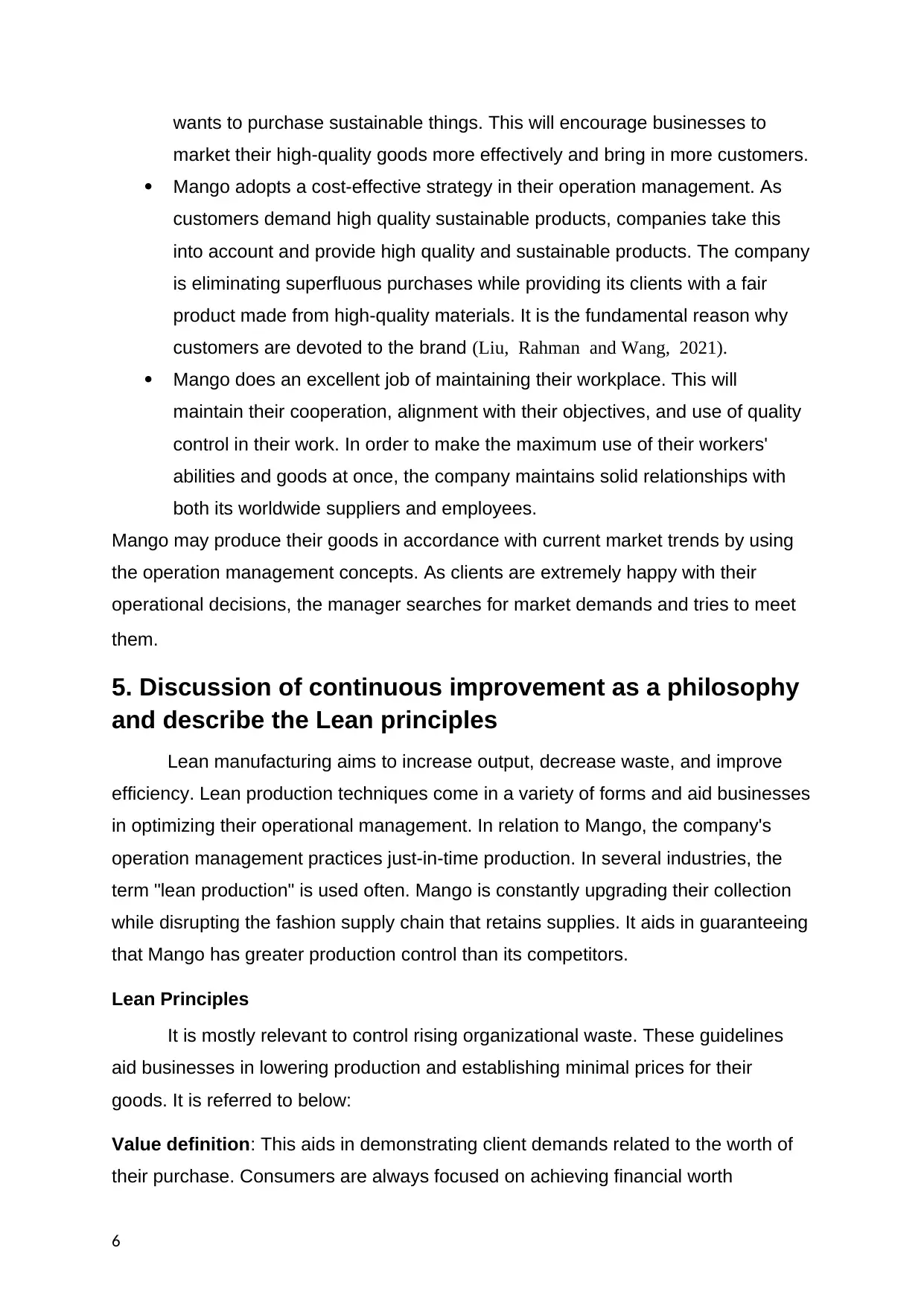
wants to purchase sustainable things. This will encourage businesses to
market their high-quality goods more effectively and bring in more customers.
Mango adopts a cost-effective strategy in their operation management. As
customers demand high quality sustainable products, companies take this
into account and provide high quality and sustainable products. The company
is eliminating superfluous purchases while providing its clients with a fair
product made from high-quality materials. It is the fundamental reason why
customers are devoted to the brand (Liu, Rahman and Wang, 2021).
Mango does an excellent job of maintaining their workplace. This will
maintain their cooperation, alignment with their objectives, and use of quality
control in their work. In order to make the maximum use of their workers'
abilities and goods at once, the company maintains solid relationships with
both its worldwide suppliers and employees.
Mango may produce their goods in accordance with current market trends by using
the operation management concepts. As clients are extremely happy with their
operational decisions, the manager searches for market demands and tries to meet
them.
5. Discussion of continuous improvement as a philosophy
and describe the Lean principles
Lean manufacturing aims to increase output, decrease waste, and improve
efficiency. Lean production techniques come in a variety of forms and aid businesses
in optimizing their operational management. In relation to Mango, the company's
operation management practices just-in-time production. In several industries, the
term "lean production" is used often. Mango is constantly upgrading their collection
while disrupting the fashion supply chain that retains supplies. It aids in guaranteeing
that Mango has greater production control than its competitors.
Lean Principles
It is mostly relevant to control rising organizational waste. These guidelines
aid businesses in lowering production and establishing minimal prices for their
goods. It is referred to below:
Value definition: This aids in demonstrating client demands related to the worth of
their purchase. Consumers are always focused on achieving financial worth
6
market their high-quality goods more effectively and bring in more customers.
Mango adopts a cost-effective strategy in their operation management. As
customers demand high quality sustainable products, companies take this
into account and provide high quality and sustainable products. The company
is eliminating superfluous purchases while providing its clients with a fair
product made from high-quality materials. It is the fundamental reason why
customers are devoted to the brand (Liu, Rahman and Wang, 2021).
Mango does an excellent job of maintaining their workplace. This will
maintain their cooperation, alignment with their objectives, and use of quality
control in their work. In order to make the maximum use of their workers'
abilities and goods at once, the company maintains solid relationships with
both its worldwide suppliers and employees.
Mango may produce their goods in accordance with current market trends by using
the operation management concepts. As clients are extremely happy with their
operational decisions, the manager searches for market demands and tries to meet
them.
5. Discussion of continuous improvement as a philosophy
and describe the Lean principles
Lean manufacturing aims to increase output, decrease waste, and improve
efficiency. Lean production techniques come in a variety of forms and aid businesses
in optimizing their operational management. In relation to Mango, the company's
operation management practices just-in-time production. In several industries, the
term "lean production" is used often. Mango is constantly upgrading their collection
while disrupting the fashion supply chain that retains supplies. It aids in guaranteeing
that Mango has greater production control than its competitors.
Lean Principles
It is mostly relevant to control rising organizational waste. These guidelines
aid businesses in lowering production and establishing minimal prices for their
goods. It is referred to below:
Value definition: This aids in demonstrating client demands related to the worth of
their purchase. Consumers are always focused on achieving financial worth
6
⊘ This is a preview!⊘
Do you want full access?
Subscribe today to unlock all pages.

Trusted by 1+ million students worldwide
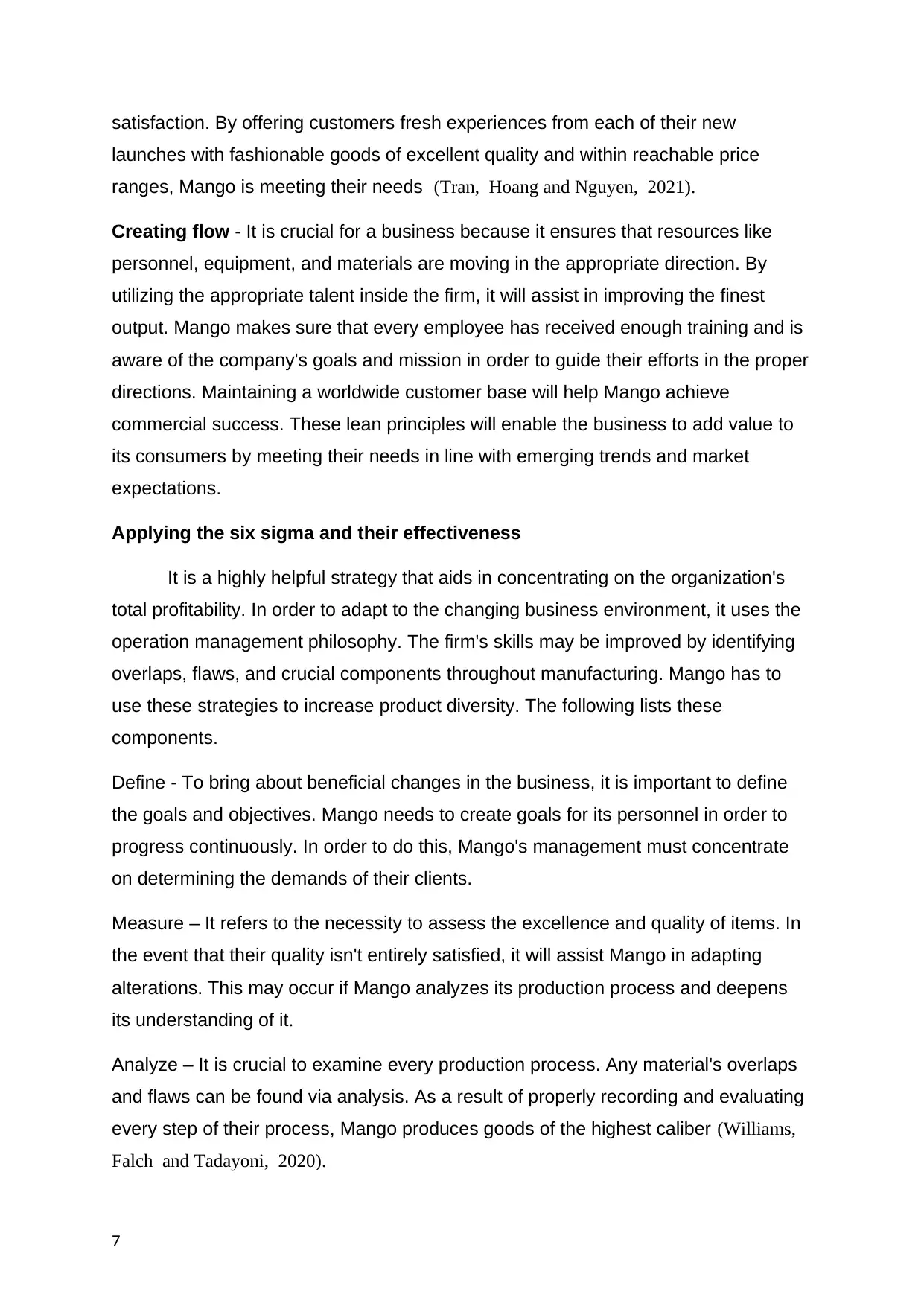
satisfaction. By offering customers fresh experiences from each of their new
launches with fashionable goods of excellent quality and within reachable price
ranges, Mango is meeting their needs (Tran, Hoang and Nguyen, 2021).
Creating flow - It is crucial for a business because it ensures that resources like
personnel, equipment, and materials are moving in the appropriate direction. By
utilizing the appropriate talent inside the firm, it will assist in improving the finest
output. Mango makes sure that every employee has received enough training and is
aware of the company's goals and mission in order to guide their efforts in the proper
directions. Maintaining a worldwide customer base will help Mango achieve
commercial success. These lean principles will enable the business to add value to
its consumers by meeting their needs in line with emerging trends and market
expectations.
Applying the six sigma and their effectiveness
It is a highly helpful strategy that aids in concentrating on the organization's
total profitability. In order to adapt to the changing business environment, it uses the
operation management philosophy. The firm's skills may be improved by identifying
overlaps, flaws, and crucial components throughout manufacturing. Mango has to
use these strategies to increase product diversity. The following lists these
components.
Define - To bring about beneficial changes in the business, it is important to define
the goals and objectives. Mango needs to create goals for its personnel in order to
progress continuously. In order to do this, Mango's management must concentrate
on determining the demands of their clients.
Measure – It refers to the necessity to assess the excellence and quality of items. In
the event that their quality isn't entirely satisfied, it will assist Mango in adapting
alterations. This may occur if Mango analyzes its production process and deepens
its understanding of it.
Analyze – It is crucial to examine every production process. Any material's overlaps
and flaws can be found via analysis. As a result of properly recording and evaluating
every step of their process, Mango produces goods of the highest caliber (Williams,
Falch and Tadayoni, 2020).
7
launches with fashionable goods of excellent quality and within reachable price
ranges, Mango is meeting their needs (Tran, Hoang and Nguyen, 2021).
Creating flow - It is crucial for a business because it ensures that resources like
personnel, equipment, and materials are moving in the appropriate direction. By
utilizing the appropriate talent inside the firm, it will assist in improving the finest
output. Mango makes sure that every employee has received enough training and is
aware of the company's goals and mission in order to guide their efforts in the proper
directions. Maintaining a worldwide customer base will help Mango achieve
commercial success. These lean principles will enable the business to add value to
its consumers by meeting their needs in line with emerging trends and market
expectations.
Applying the six sigma and their effectiveness
It is a highly helpful strategy that aids in concentrating on the organization's
total profitability. In order to adapt to the changing business environment, it uses the
operation management philosophy. The firm's skills may be improved by identifying
overlaps, flaws, and crucial components throughout manufacturing. Mango has to
use these strategies to increase product diversity. The following lists these
components.
Define - To bring about beneficial changes in the business, it is important to define
the goals and objectives. Mango needs to create goals for its personnel in order to
progress continuously. In order to do this, Mango's management must concentrate
on determining the demands of their clients.
Measure – It refers to the necessity to assess the excellence and quality of items. In
the event that their quality isn't entirely satisfied, it will assist Mango in adapting
alterations. This may occur if Mango analyzes its production process and deepens
its understanding of it.
Analyze – It is crucial to examine every production process. Any material's overlaps
and flaws can be found via analysis. As a result of properly recording and evaluating
every step of their process, Mango produces goods of the highest caliber (Williams,
Falch and Tadayoni, 2020).
7
Paraphrase This Document
Need a fresh take? Get an instant paraphrase of this document with our AI Paraphraser

Design - By reducing unnecessary waste, it offers a precise understanding of the
goods. To enhance consumer retention, Mango has to be more precise about
developing its items in a more sustainable way.
Verify: In this final stage, Mango will confirm that every step of their current
procedure has been completed. This will reveal whether the designs, aims, and
control are adequately regulated.
Continuous Improvement
In order to satisfy customers, this is an integrated management philosophy
that constantly seeks to improve the quality of both the goods and the processes. It
is a primary issue that encompasses all organization operations and is founded on
principles, which is more significant. This is crucial for the business in order to modify
their work in response to client demand. The market will face additional obstacles as
a result of improvements. It aids in reducing waste and makes use of affordable
resources and inventories. By consistently focusing on their management and
operations, Mango may be the competition.
6. A continuous improvement plan, including your justified
recommendations for improvement, based on your review
and critique of operations management principles within
your organization
The development of a continuous improvement strategy is crucial for ensuring
that manufacturing process quality problems are dealt with. It may be accomplished
by using Mango in the framework of the PDCA technique.
Plan- It is a planning process that identifies market demands and potential
organizational changes. Mango must schedule daily adjustments to market behavior.
Do - To bring about changes in the organization, Mango must begin putting their
practice into action. Since the practice will only last a limited time, it will begin as an
original change. The Mango staff will be able to adopt the same task with great
productivity.
Check: Effective management and monitoring of changes is required. As the
manager of Mango, you must operate under close supervision to minimize the
possibility of errors.
8
goods. To enhance consumer retention, Mango has to be more precise about
developing its items in a more sustainable way.
Verify: In this final stage, Mango will confirm that every step of their current
procedure has been completed. This will reveal whether the designs, aims, and
control are adequately regulated.
Continuous Improvement
In order to satisfy customers, this is an integrated management philosophy
that constantly seeks to improve the quality of both the goods and the processes. It
is a primary issue that encompasses all organization operations and is founded on
principles, which is more significant. This is crucial for the business in order to modify
their work in response to client demand. The market will face additional obstacles as
a result of improvements. It aids in reducing waste and makes use of affordable
resources and inventories. By consistently focusing on their management and
operations, Mango may be the competition.
6. A continuous improvement plan, including your justified
recommendations for improvement, based on your review
and critique of operations management principles within
your organization
The development of a continuous improvement strategy is crucial for ensuring
that manufacturing process quality problems are dealt with. It may be accomplished
by using Mango in the framework of the PDCA technique.
Plan- It is a planning process that identifies market demands and potential
organizational changes. Mango must schedule daily adjustments to market behavior.
Do - To bring about changes in the organization, Mango must begin putting their
practice into action. Since the practice will only last a limited time, it will begin as an
original change. The Mango staff will be able to adopt the same task with great
productivity.
Check: Effective management and monitoring of changes is required. As the
manager of Mango, you must operate under close supervision to minimize the
possibility of errors.
8
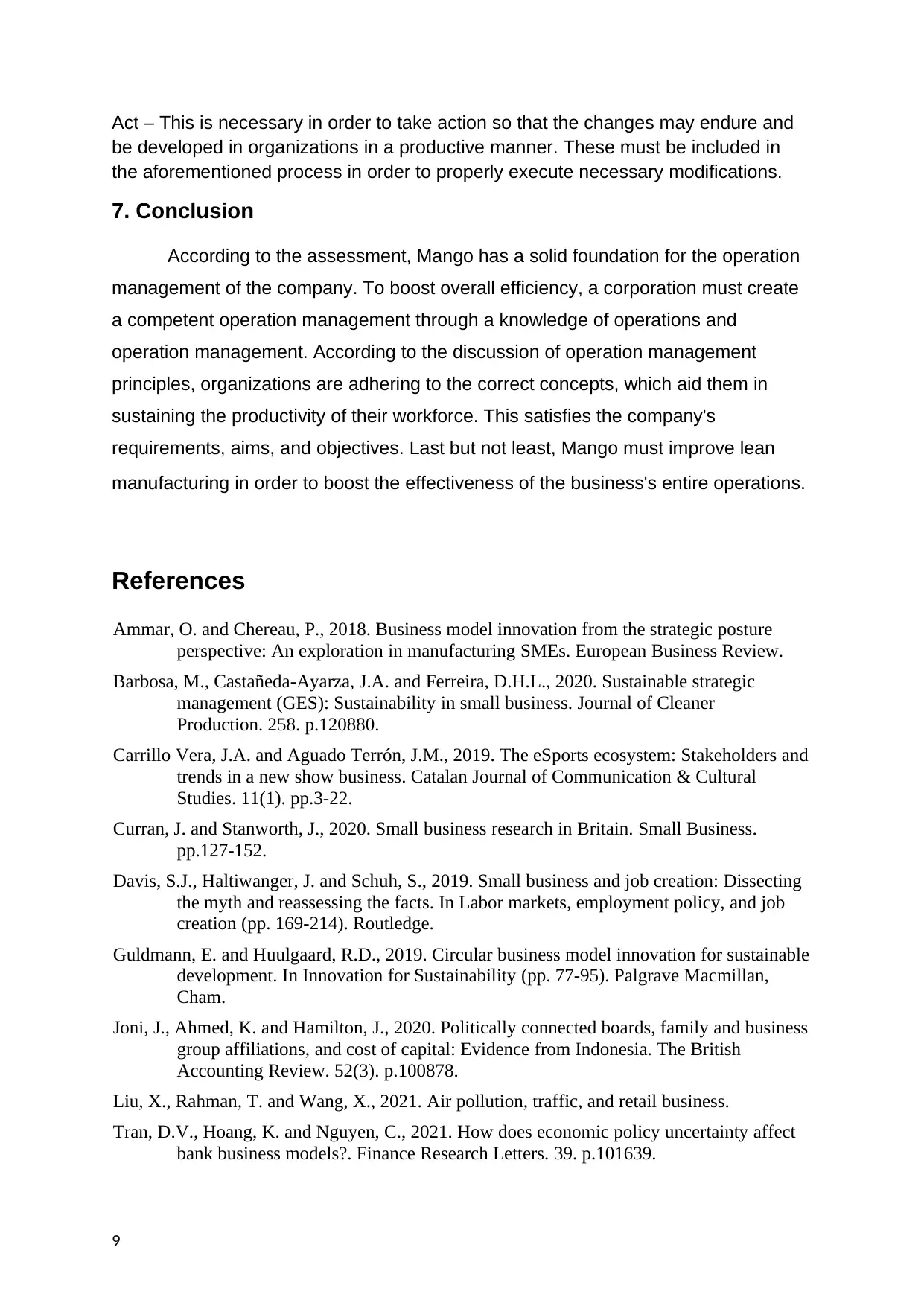
Act – This is necessary in order to take action so that the changes may endure and
be developed in organizations in a productive manner. These must be included in
the aforementioned process in order to properly execute necessary modifications.
7. Conclusion
According to the assessment, Mango has a solid foundation for the operation
management of the company. To boost overall efficiency, a corporation must create
a competent operation management through a knowledge of operations and
operation management. According to the discussion of operation management
principles, organizations are adhering to the correct concepts, which aid them in
sustaining the productivity of their workforce. This satisfies the company's
requirements, aims, and objectives. Last but not least, Mango must improve lean
manufacturing in order to boost the effectiveness of the business's entire operations.
References
Ammar, O. and Chereau, P., 2018. Business model innovation from the strategic posture
perspective: An exploration in manufacturing SMEs. European Business Review.
Barbosa, M., Castañeda-Ayarza, J.A. and Ferreira, D.H.L., 2020. Sustainable strategic
management (GES): Sustainability in small business. Journal of Cleaner
Production. 258. p.120880.
Carrillo Vera, J.A. and Aguado Terrón, J.M., 2019. The eSports ecosystem: Stakeholders and
trends in a new show business. Catalan Journal of Communication & Cultural
Studies. 11(1). pp.3-22.
Curran, J. and Stanworth, J., 2020. Small business research in Britain. Small Business.
pp.127-152.
Davis, S.J., Haltiwanger, J. and Schuh, S., 2019. Small business and job creation: Dissecting
the myth and reassessing the facts. In Labor markets, employment policy, and job
creation (pp. 169-214). Routledge.
Guldmann, E. and Huulgaard, R.D., 2019. Circular business model innovation for sustainable
development. In Innovation for Sustainability (pp. 77-95). Palgrave Macmillan,
Cham.
Joni, J., Ahmed, K. and Hamilton, J., 2020. Politically connected boards, family and business
group affiliations, and cost of capital: Evidence from Indonesia. The British
Accounting Review. 52(3). p.100878.
Liu, X., Rahman, T. and Wang, X., 2021. Air pollution, traffic, and retail business.
Tran, D.V., Hoang, K. and Nguyen, C., 2021. How does economic policy uncertainty affect
bank business models?. Finance Research Letters. 39. p.101639.
9
be developed in organizations in a productive manner. These must be included in
the aforementioned process in order to properly execute necessary modifications.
7. Conclusion
According to the assessment, Mango has a solid foundation for the operation
management of the company. To boost overall efficiency, a corporation must create
a competent operation management through a knowledge of operations and
operation management. According to the discussion of operation management
principles, organizations are adhering to the correct concepts, which aid them in
sustaining the productivity of their workforce. This satisfies the company's
requirements, aims, and objectives. Last but not least, Mango must improve lean
manufacturing in order to boost the effectiveness of the business's entire operations.
References
Ammar, O. and Chereau, P., 2018. Business model innovation from the strategic posture
perspective: An exploration in manufacturing SMEs. European Business Review.
Barbosa, M., Castañeda-Ayarza, J.A. and Ferreira, D.H.L., 2020. Sustainable strategic
management (GES): Sustainability in small business. Journal of Cleaner
Production. 258. p.120880.
Carrillo Vera, J.A. and Aguado Terrón, J.M., 2019. The eSports ecosystem: Stakeholders and
trends in a new show business. Catalan Journal of Communication & Cultural
Studies. 11(1). pp.3-22.
Curran, J. and Stanworth, J., 2020. Small business research in Britain. Small Business.
pp.127-152.
Davis, S.J., Haltiwanger, J. and Schuh, S., 2019. Small business and job creation: Dissecting
the myth and reassessing the facts. In Labor markets, employment policy, and job
creation (pp. 169-214). Routledge.
Guldmann, E. and Huulgaard, R.D., 2019. Circular business model innovation for sustainable
development. In Innovation for Sustainability (pp. 77-95). Palgrave Macmillan,
Cham.
Joni, J., Ahmed, K. and Hamilton, J., 2020. Politically connected boards, family and business
group affiliations, and cost of capital: Evidence from Indonesia. The British
Accounting Review. 52(3). p.100878.
Liu, X., Rahman, T. and Wang, X., 2021. Air pollution, traffic, and retail business.
Tran, D.V., Hoang, K. and Nguyen, C., 2021. How does economic policy uncertainty affect
bank business models?. Finance Research Letters. 39. p.101639.
9
⊘ This is a preview!⊘
Do you want full access?
Subscribe today to unlock all pages.

Trusted by 1+ million students worldwide
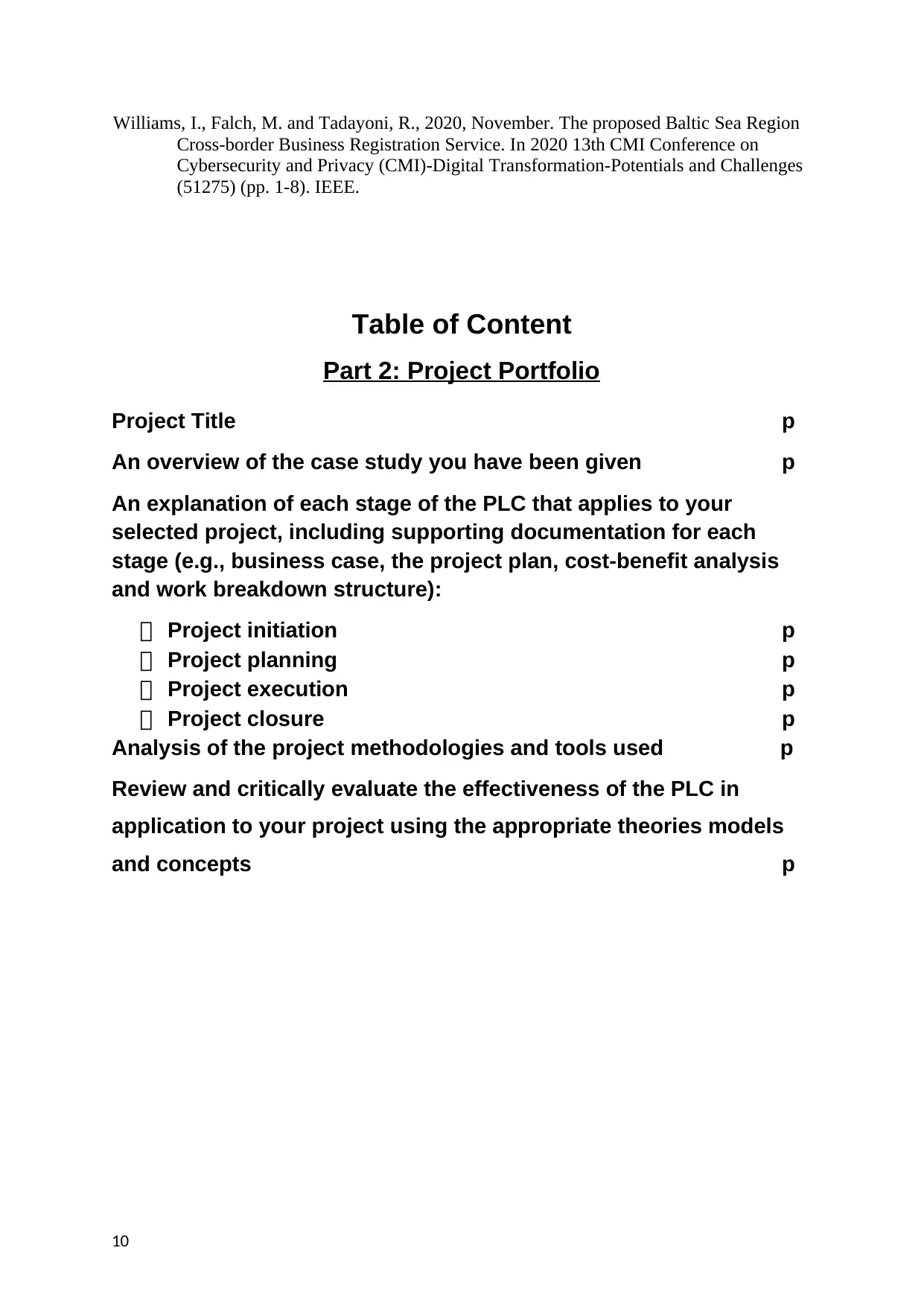
Williams, I., Falch, M. and Tadayoni, R., 2020, November. The proposed Baltic Sea Region
Cross-border Business Registration Service. In 2020 13th CMI Conference on
Cybersecurity and Privacy (CMI)-Digital Transformation-Potentials and Challenges
(51275) (pp. 1-8). IEEE.
Table of Content
Part 2: Project Portfolio
Project Title p
An overview of the case study you have been given p
An explanation of each stage of the PLC that applies to your
selected project, including supporting documentation for each
stage (e.g., business case, the project plan, cost-benefit analysis
and work breakdown structure):
Project initiation p
Project planning p
Project execution p
Project closure p
Analysis of the project methodologies and tools used p
Review and critically evaluate the effectiveness of the PLC in
application to your project using the appropriate theories models
and concepts p
10
Cross-border Business Registration Service. In 2020 13th CMI Conference on
Cybersecurity and Privacy (CMI)-Digital Transformation-Potentials and Challenges
(51275) (pp. 1-8). IEEE.
Table of Content
Part 2: Project Portfolio
Project Title p
An overview of the case study you have been given p
An explanation of each stage of the PLC that applies to your
selected project, including supporting documentation for each
stage (e.g., business case, the project plan, cost-benefit analysis
and work breakdown structure):
Project initiation p
Project planning p
Project execution p
Project closure p
Analysis of the project methodologies and tools used p
Review and critically evaluate the effectiveness of the PLC in
application to your project using the appropriate theories models
and concepts p
10
Paraphrase This Document
Need a fresh take? Get an instant paraphrase of this document with our AI Paraphraser
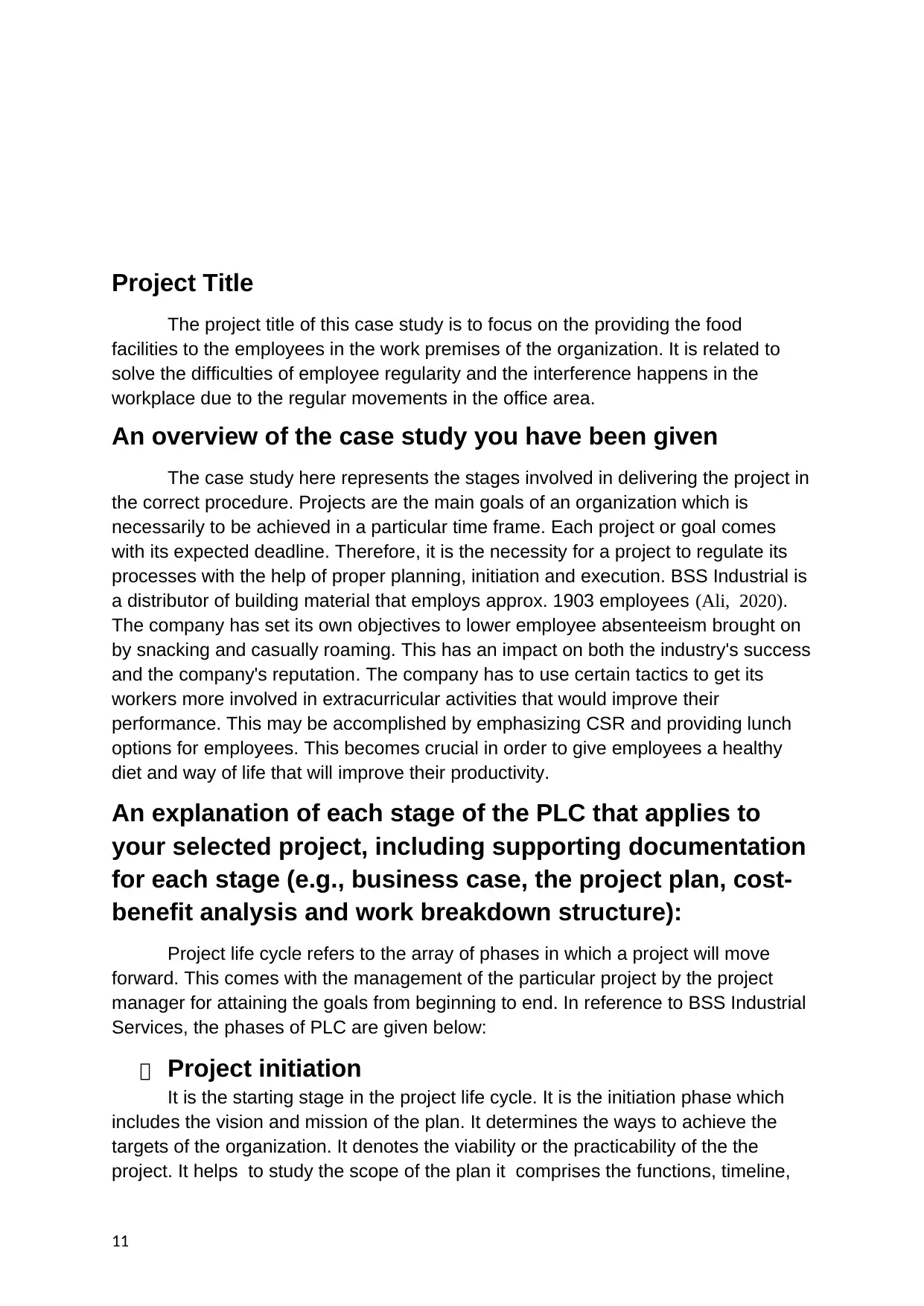
Project Title
The project title of this case study is to focus on the providing the food
facilities to the employees in the work premises of the organization. It is related to
solve the difficulties of employee regularity and the interference happens in the
workplace due to the regular movements in the office area.
An overview of the case study you have been given
The case study here represents the stages involved in delivering the project in
the correct procedure. Projects are the main goals of an organization which is
necessarily to be achieved in a particular time frame. Each project or goal comes
with its expected deadline. Therefore, it is the necessity for a project to regulate its
processes with the help of proper planning, initiation and execution. BSS Industrial is
a distributor of building material that employs approx. 1903 employees (Ali, 2020).
The company has set its own objectives to lower employee absenteeism brought on
by snacking and casually roaming. This has an impact on both the industry's success
and the company's reputation. The company has to use certain tactics to get its
workers more involved in extracurricular activities that would improve their
performance. This may be accomplished by emphasizing CSR and providing lunch
options for employees. This becomes crucial in order to give employees a healthy
diet and way of life that will improve their productivity.
An explanation of each stage of the PLC that applies to
your selected project, including supporting documentation
for each stage (e.g., business case, the project plan, cost-
benefit analysis and work breakdown structure):
Project life cycle refers to the array of phases in which a project will move
forward. This comes with the management of the particular project by the project
manager for attaining the goals from beginning to end. In reference to BSS Industrial
Services, the phases of PLC are given below:
Project initiation
It is the starting stage in the project life cycle. It is the initiation phase which
includes the vision and mission of the plan. It determines the ways to achieve the
targets of the organization. It denotes the viability or the practicability of the the
project. It helps to study the scope of the plan it comprises the functions, timeline,
11
The project title of this case study is to focus on the providing the food
facilities to the employees in the work premises of the organization. It is related to
solve the difficulties of employee regularity and the interference happens in the
workplace due to the regular movements in the office area.
An overview of the case study you have been given
The case study here represents the stages involved in delivering the project in
the correct procedure. Projects are the main goals of an organization which is
necessarily to be achieved in a particular time frame. Each project or goal comes
with its expected deadline. Therefore, it is the necessity for a project to regulate its
processes with the help of proper planning, initiation and execution. BSS Industrial is
a distributor of building material that employs approx. 1903 employees (Ali, 2020).
The company has set its own objectives to lower employee absenteeism brought on
by snacking and casually roaming. This has an impact on both the industry's success
and the company's reputation. The company has to use certain tactics to get its
workers more involved in extracurricular activities that would improve their
performance. This may be accomplished by emphasizing CSR and providing lunch
options for employees. This becomes crucial in order to give employees a healthy
diet and way of life that will improve their productivity.
An explanation of each stage of the PLC that applies to
your selected project, including supporting documentation
for each stage (e.g., business case, the project plan, cost-
benefit analysis and work breakdown structure):
Project life cycle refers to the array of phases in which a project will move
forward. This comes with the management of the particular project by the project
manager for attaining the goals from beginning to end. In reference to BSS Industrial
Services, the phases of PLC are given below:
Project initiation
It is the starting stage in the project life cycle. It is the initiation phase which
includes the vision and mission of the plan. It determines the ways to achieve the
targets of the organization. It denotes the viability or the practicability of the the
project. It helps to study the scope of the plan it comprises the functions, timeline,
11
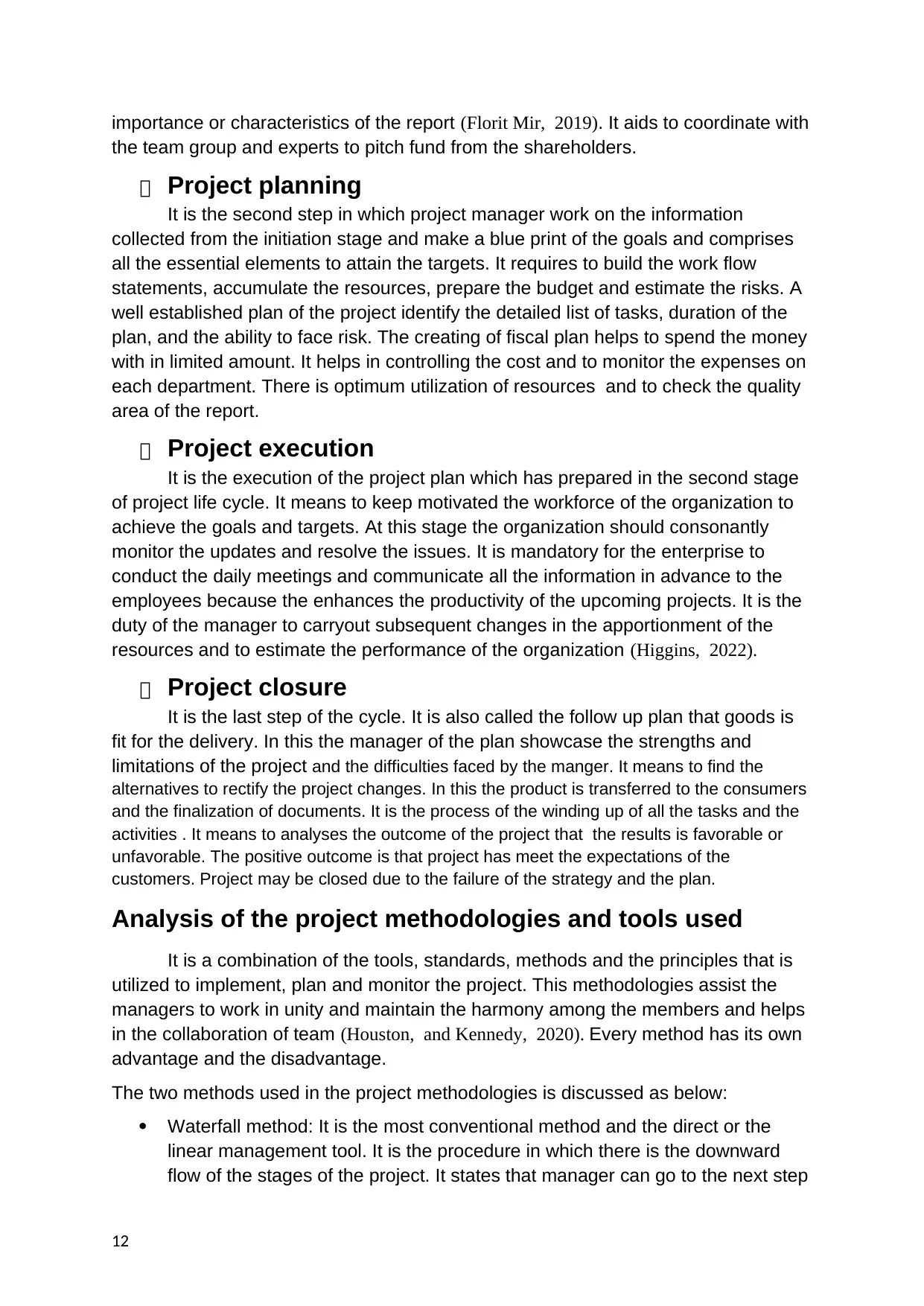
importance or characteristics of the report (Florit Mir, 2019). It aids to coordinate with
the team group and experts to pitch fund from the shareholders.
Project planning
It is the second step in which project manager work on the information
collected from the initiation stage and make a blue print of the goals and comprises
all the essential elements to attain the targets. It requires to build the work flow
statements, accumulate the resources, prepare the budget and estimate the risks. A
well established plan of the project identify the detailed list of tasks, duration of the
plan, and the ability to face risk. The creating of fiscal plan helps to spend the money
with in limited amount. It helps in controlling the cost and to monitor the expenses on
each department. There is optimum utilization of resources and to check the quality
area of the report.
Project execution
It is the execution of the project plan which has prepared in the second stage
of project life cycle. It means to keep motivated the workforce of the organization to
achieve the goals and targets. At this stage the organization should consonantly
monitor the updates and resolve the issues. It is mandatory for the enterprise to
conduct the daily meetings and communicate all the information in advance to the
employees because the enhances the productivity of the upcoming projects. It is the
duty of the manager to carryout subsequent changes in the apportionment of the
resources and to estimate the performance of the organization (Higgins, 2022).
Project closure
It is the last step of the cycle. It is also called the follow up plan that goods is
fit for the delivery. In this the manager of the plan showcase the strengths and
limitations of the project and the difficulties faced by the manger. It means to find the
alternatives to rectify the project changes. In this the product is transferred to the consumers
and the finalization of documents. It is the process of the winding up of all the tasks and the
activities . It means to analyses the outcome of the project that the results is favorable or
unfavorable. The positive outcome is that project has meet the expectations of the
customers. Project may be closed due to the failure of the strategy and the plan.
Analysis of the project methodologies and tools used
It is a combination of the tools, standards, methods and the principles that is
utilized to implement, plan and monitor the project. This methodologies assist the
managers to work in unity and maintain the harmony among the members and helps
in the collaboration of team (Houston, and Kennedy, 2020). Every method has its own
advantage and the disadvantage.
The two methods used in the project methodologies is discussed as below:
Waterfall method: It is the most conventional method and the direct or the
linear management tool. It is the procedure in which there is the downward
flow of the stages of the project. It states that manager can go to the next step
12
the team group and experts to pitch fund from the shareholders.
Project planning
It is the second step in which project manager work on the information
collected from the initiation stage and make a blue print of the goals and comprises
all the essential elements to attain the targets. It requires to build the work flow
statements, accumulate the resources, prepare the budget and estimate the risks. A
well established plan of the project identify the detailed list of tasks, duration of the
plan, and the ability to face risk. The creating of fiscal plan helps to spend the money
with in limited amount. It helps in controlling the cost and to monitor the expenses on
each department. There is optimum utilization of resources and to check the quality
area of the report.
Project execution
It is the execution of the project plan which has prepared in the second stage
of project life cycle. It means to keep motivated the workforce of the organization to
achieve the goals and targets. At this stage the organization should consonantly
monitor the updates and resolve the issues. It is mandatory for the enterprise to
conduct the daily meetings and communicate all the information in advance to the
employees because the enhances the productivity of the upcoming projects. It is the
duty of the manager to carryout subsequent changes in the apportionment of the
resources and to estimate the performance of the organization (Higgins, 2022).
Project closure
It is the last step of the cycle. It is also called the follow up plan that goods is
fit for the delivery. In this the manager of the plan showcase the strengths and
limitations of the project and the difficulties faced by the manger. It means to find the
alternatives to rectify the project changes. In this the product is transferred to the consumers
and the finalization of documents. It is the process of the winding up of all the tasks and the
activities . It means to analyses the outcome of the project that the results is favorable or
unfavorable. The positive outcome is that project has meet the expectations of the
customers. Project may be closed due to the failure of the strategy and the plan.
Analysis of the project methodologies and tools used
It is a combination of the tools, standards, methods and the principles that is
utilized to implement, plan and monitor the project. This methodologies assist the
managers to work in unity and maintain the harmony among the members and helps
in the collaboration of team (Houston, and Kennedy, 2020). Every method has its own
advantage and the disadvantage.
The two methods used in the project methodologies is discussed as below:
Waterfall method: It is the most conventional method and the direct or the
linear management tool. It is the procedure in which there is the downward
flow of the stages of the project. It states that manager can go to the next step
12
⊘ This is a preview!⊘
Do you want full access?
Subscribe today to unlock all pages.

Trusted by 1+ million students worldwide
1 out of 14
Related Documents
Your All-in-One AI-Powered Toolkit for Academic Success.
+13062052269
info@desklib.com
Available 24*7 on WhatsApp / Email
![[object Object]](/_next/static/media/star-bottom.7253800d.svg)
Unlock your academic potential
Copyright © 2020–2025 A2Z Services. All Rights Reserved. Developed and managed by ZUCOL.


